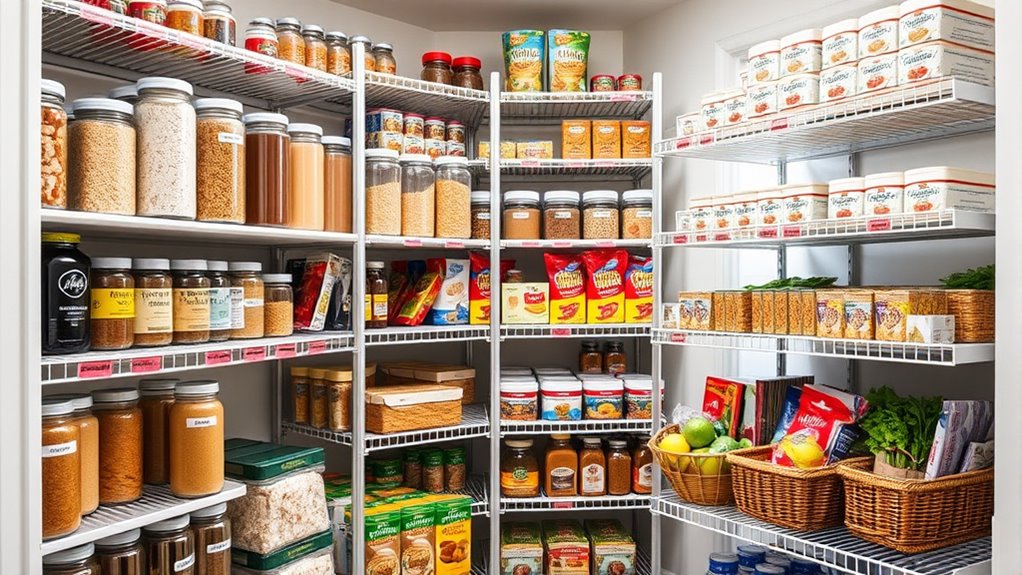Creating designated pantry zones and using clear, durable labels can make your space more organized and practical. Group similar items like snacks, canned goods, and baking supplies in specific areas, and label each shelf or container for easy identification. This helps you quickly find what you need, keep clutter in check, and streamline grocery shopping and meal prep. Keep your system fresh and effective with simple updates—you’ll discover tips that keep your pantry totally grocery-day ready.
Key Takeaways
- Establish dedicated zones for categories like baking, snacks, and canned goods to streamline grocery shopping and meal prep.
- Use clear, moisture-resistant labels on shelves and containers for easy identification and organization.
- Regularly update labels and reorganize zones to accommodate seasonal items and household changes.
- Group similar items together within zones to reduce clutter and improve accessibility.
- Maintain the system by periodically revisiting and adjusting zones and labels for maximum efficiency.

Ever wondered how to make your pantry more organized and easy to navigate? The secret lies in creating dedicated pantry zones and utilizing clear labels. When you assign specific areas for different types of items, you save time hunting for that bag of rice or the snack stash. Instead of rummaging through cluttered shelves, you’ll effortlessly find what you need and keep your pantry looking tidy. It’s a simple step that transforms chaos into order and makes grocery shopping and meal prep more efficient.
Start by categorizing your pantry items into logical zones. For example, dedicate one section to baking supplies—flour, sugar, baking soda—so you know exactly where everything is when you’re baking. Another zone could be snacks and cereals, while separate spaces work well for canned goods, condiments, and breakfast items. If you have kids, consider creating a zone just for their snacks and lunchbox essentials. The key is to group similar items together, which reduces clutter and makes restocking easier. As you organize, discard expired or unused products to create more space and keep your pantry fresh.
Categorize pantry items into zones like baking, snacks, and canned goods for easier organization and restocking.
Once your zones are established, labels become your best friend. Clear, visible labels help everyone in the household know where things belong, preventing random items from piling up on countertops or in other areas. Use labels that are easy to read and resistant to smudging or moisture—think laminated labels or chalkboard tags. Stick or tape them onto shelves, bins, or containers, ensuring each zone is clearly marked. This not only streamlines your daily routines but also encourages family members to put things back in their designated spots, maintaining the order over time.
Having designated zones and labels also simplifies your grocery shopping. When you run out of a specific item, you’ll know exactly which zone to check first. This prevents unnecessary browsing and helps you create more accurate shopping lists. Additionally, it encourages better inventory management. You can see at a glance what’s running low, what’s overstocked, or what needs to be used up soon, helping you minimize waste and save money. Incorporating organized storage solutions from best laundry detergents can further enhance your pantry’s functionality and freshness.
Finally, maintaining this system is straightforward. Regularly revisit your zones and labels to adjust for seasonal items or changing household needs. Keep your labels updated, and reorganize as necessary to keep everything functional. With a bit of effort upfront, you’ll have a pantry that’s not only grocery-day ready but also a pleasure to use every day. The result is a space that’s efficient, clutter-free, and inviting—making your kitchen chores less of a hassle and more of a breeze.
Frequently Asked Questions
How Often Should Pantry Zones Be Reorganized?
You should reorganize your pantry zones every 3 to 6 months to keep everything accessible and tidy. Regular reorganization helps you spot expired items and prevents clutter from building up. If you notice your pantry getting messy or items falling out of place more often, do it sooner. Maintaining a habit of periodic checks guarantees your pantry stays functional, organized, and ready for your next grocery day.
What Materials Are Best for Durable Pantry Labels?
You’re only as good as your tools, so choose durable pantry labels. Waterproof vinyl or laminated paper works best because they resist moisture, tears, and fading. Keep in mind, “A stitch in time saves nine,” so investing in sturdy labels now prevents hassle later. Opt for self-adhesive, weatherproof options for easy application and longevity. This way, your pantry stays organized and labels stay clear, no matter what life throws at you.
How Can I Prevent Pests in Pantry Zones?
To prevent pests in your pantry zones, keep everything sealed tightly in airtight containers. Regularly clean shelves and floors to eliminate crumbs and spills that attract bugs. Use natural repellents like bay leaves or herbs, and consider installing door sweeps or screens to block entry points. Also, avoid overstocking, which makes it harder to spot pests early. Consistent maintenance and cleanliness are key to keeping your pantry pest-free.
Are There Eco-Friendly Labeling Options Available?
You’ll be glad to know eco-friendly labeling options are readily available. You can choose plant-based inks, recycled paper, or biodegradable labels that break down naturally. These options often come with stylish designs, making your pantry both organized and environmentally conscious. As you incorporate these labels, you might discover that your efforts not only reduce waste but also inspire others around you to adopt sustainable habits effortlessly.
How Do I Handle Expired Items in My Pantry?
When you find expired items in your pantry, start by checking if they can be safely discarded or repurposed. Dispose of expired foods responsibly, following local guidelines for waste. Clean the storage area thoroughly to prevent contamination. Consider creating a system to regularly check expiration dates, like monthly audits. This helps you stay organized, avoid waste, and keep your pantry fresh and safe for everyday use.
Conclusion
By organizing your pantry zones and adding clear labels, you’re not just creating order—you’re building a foundation of clarity and control. Think of each labeled zone as a waypoint on your journey toward a calmer, more efficient life. When everything has its place, you free your mind from chaos, allowing your home to reflect the harmony you seek. Embrace this system as a symbol of your commitment to balance and intentional living.








